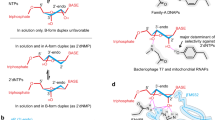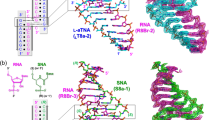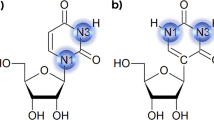Abstract
CRYSTAL structure determinations of nucleic acid fragments have shown that several of the conformational features found in the monomeric building blocks are also manifested at the nucleic acid level. Stereochemical variations between thymine and uracil nucleotides are therefore of interest as they can provide a structural basis for some of the differences between the conformations of DNA and RNA. X-ray studies have so far not shown any major dissimilarities between these two nucleotide species although the sugar ring of deoxyribonucleotides is found to possess greater flexibility than that in ribonucleotides. We report here the molecular structure of deoxyuridine-5′-phosphate (dUMP-5′) which is not a common monomer unit of DNAs as it is replaced by its 5-methyl analogue deoxythymidine-5′-phosphate (dTMP-5′). The investigation was undertaken to help determine whether or not this implied a fundamental difference between the geometries of these two molecules.
This is a preview of subscription content, access via your institution
Access options
Subscribe to this journal
Receive 51 print issues and online access
$199.00 per year
only $3.90 per issue
Buy this article
- Purchase on Springer Link
- Instant access to full article PDF
Prices may be subject to local taxes which are calculated during checkout
Similar content being viewed by others
References
Trueblood, K. N., Horn, P., and Luzzati, V., Acta Crystallogr., 14, 965–982 (1961).
Camerman, N., Fawcett, J. K., and Camerman, A., Science, 182, 1142–1143 (1973).
Seshadri, T. P., and Viswamitra, M. A., Curr. Sci., 42, 85–86 (1973).
Shefter, E., and Trueblood, K. N., Acta Crystallogr., 18, 1067–1077 (1965).
Seshadri, T. P., Reddy, B. S., Viswamitra, M. A., and Kartha, G., Curr. Sci., 43, 339–340 (1974).
Sundaralingam, M., Biopolymers, 7, 821–860 (1974).
Sundaralingam, M., Fifth Jerusalem Symp. Quantum Chem. Biochem. (edit. by Bergmann, E. D., and Pullman, B.), 417–455 (Israel Academy of Sciences and Humanities, 1973).
Sundaralingam, M., Int. J. quant. Chem. quant. Biol. Symp. no., 1, 81–91 (1974).
Young, D. W., Tollin, P., and Wilson, H. R., Nature, 248, 513–514 (1974).
Viswamitra, M. A., and Seshadri, T. P., Nature, 252, 176–177 (1974).
Saenger, W., and Suck, D., Nature, 242, 610–612 (1973).
Arnott, S., Dover, S. D., and Wonacott, A., Acta Crystallogr., B 25, 2192–2206 (1969).
Crick, F. H. C., and Klug, A., Nature, 255, 530–533 (1975).
Author information
Authors and Affiliations
Rights and permissions
About this article
Cite this article
VISWAMITRA, M., SESHADRI, T. & POST, M. An uncommon nucleotide conformation shown by molecular structure of deoxyuridine-5′-phosphate and nucleic acid stereochemistry. Nature 258, 542–544 (1975). https://doi.org/10.1038/258542a0
Received:
Accepted:
Issue Date:
DOI: https://doi.org/10.1038/258542a0
This article is cited by
-
Potential energy calculations and stereochemical studies of 5?-thiomethyladenosine: A catabolite ofS-adenosylmethionine
Journal of Crystal and Molecular Structure (1980)
-
Nucleotide rigidity
Nature (1976)
Comments
By submitting a comment you agree to abide by our Terms and Community Guidelines. If you find something abusive or that does not comply with our terms or guidelines please flag it as inappropriate.



